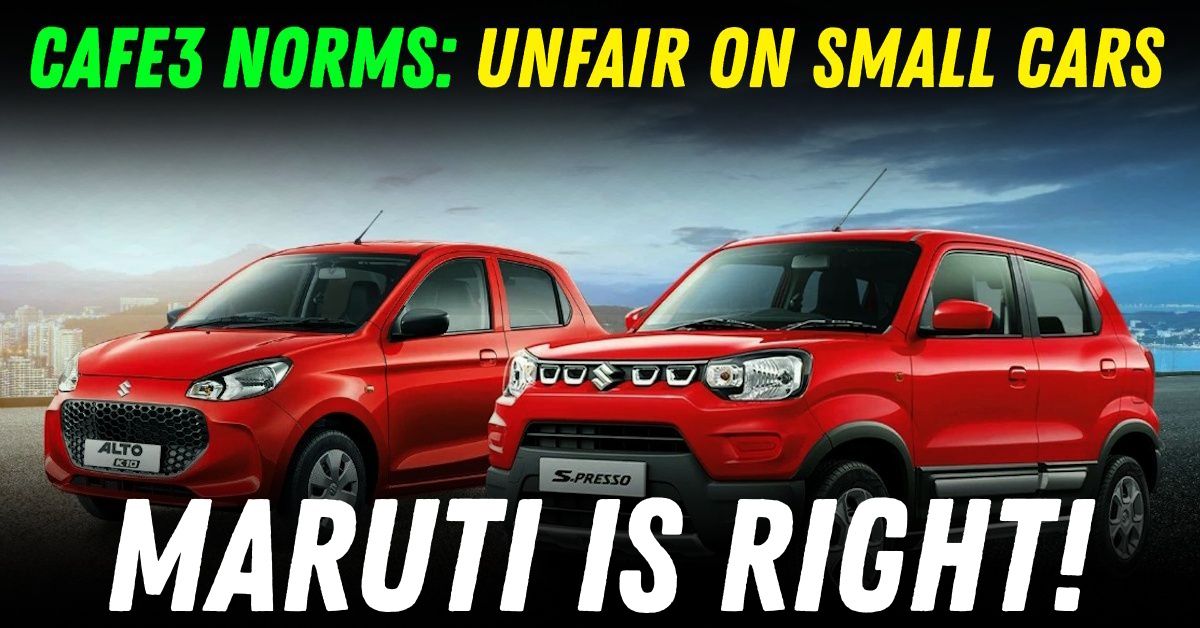Mahindra And Tata's Contradictory Positions On CAFE3 Norms Proves Why Maruti Is Right!


The auto industry is caught in a growing debate over the new Corporate Average Fuel Efficiency (CAFE3) norms, and some of the loudest voices are also the most confusing. Tata Motors and Mahindra & Mahindra are speaking in two different tones depending on which part of their business is under the spotlight. On one hand, they reject the idea of any relaxation for small cars under these new norms. On the other, they are pushing hard for full exemptions for their small commercial vehicles. This contradiction is hard to ignore and brings fresh attention to Maruti Suzuki’s consistent position on the issue.
From April 2027, all carmakers will need to bring down their average carbon dioxide (CO2) emissions to 91.7 grams per kilometre. That is a sharp drop from the current limit of 113 grams. But the way this rule works is where the real issue begins. The formula gives an advantage to heavier cars, which makes it tougher for small, fuel-efficient vehicles to meet the targets.
Maruti Suzuki, which has a range of models that weigh under 1,000 kg, has raised a valid point. For instance, a small petrol car that emits 97 grams of CO2 per kilometre could fail the test, while a much heavier diesel SUV emitting 128 grams might pass. The system ends up punishing efficient cars and rewarding the opposite.
The story gets more interesting when we look at how Tata and Mahindra treat commercial vehicles. While they talk tough on emissions in the case of passenger cars, they are requesting full exemptions for small commercial vehicles under 3.5 tonnes. Their main reason? They say that such vehicles are owned by small business operators who cannot afford expensive upgrades.
They argue that nearly 80 percent of small commercial vehicle owners are driver-operators and that buying a new vehicle in India costs more than 40 months of income, compared to about 10 months in Europe. Ironically, these are the same affordability points Maruti raises for small car buyers, yet those concerns are dismissed when it comes to passenger vehicles.
Here is where the contradiction becomes hard to defend. Tata and Mahindra say small cars make up 60 percent of all passenger vehicle sales but are responsible for 53 percent of emissions. So, they argue against relaxing norms for these cars. At the same time, they want their small commercial vehicles, used more intensively and for longer distances, to be exempt entirely from these rules.
Mahindra’s communication to the government even claims that giving relief to small cars would lock in high emissions for the future. But this environmental concern disappears when it comes to their own commercial offerings. Suddenly, affordability takes centre stage. This clearly shows that their support for strict emission rules depends entirely on how it affects their own business.
Seen through this lens, Maruti Suzuki’s argument appears more grounded. The company has said from the start that the weight-based system is flawed. Lightweight cars naturally use less fuel, need fewer resources to make, and emit less carbon overall.
The current rule allows carmakers to continue making big, fuel-hungry SUVs and still meet targets by selling a few electric models or using the weight adjustment trick. This does not actually reduce pollution, it just shifts numbers around on paper.
Maruti’s Chairman R.C. Bhargava has also talked about how rising costs are hurting small car sales. From FY17 to FY25, this segment dropped by 35 percent. Only about 12 percent of Indian households earn more than ₹12 lakh annually, so many families are being priced out of the market for their first car.
What Tata and Mahindra are doing is not just bad optics, it shows how companies shift their views depending on which part of the market they dominate. They support environmental action when it affects someone else but ask for leniency when their own products are involved. This weakens their stand against Maruti’s proposal and suggests that their focus is more on profits than on cleaner air.
If affordability is a good reason to protect small commercial vehicle buyers, why should it be ignored for families who are struggling to buy their first car?
Instead of sticking to a one-size-fits-all rule, the government could explore a more practical approach. Maruti has suggested having separate rules for vehicles under 1,000 kg, not to escape regulation, but to reward true efficiency.
Right now, the formula seems to favour bulk over brains. Heavier vehicles with batteries can meet targets more easily than genuinely efficient, lightweight cars. That does not help the environment and does not encourage better design.
The CAFE3 debate has shone a light on the selective approach of Tata and Mahindra. By trying to block relief for small cars while asking for exemptions for commercial ones, they have exposed the gap between their words and actions.
This gives Maruti Suzuki’s case more weight and shows why we need emission rules that actually work, both for the environment and for people who still dream of owning a car.
In a market where every rupee counts and where real-world pollution needs real action, it is time to stop playing favourites. A fair, balanced policy that encourages efficiency without hurting accessibility is what India truly needs. And that is exactly what Maruti is asking for.